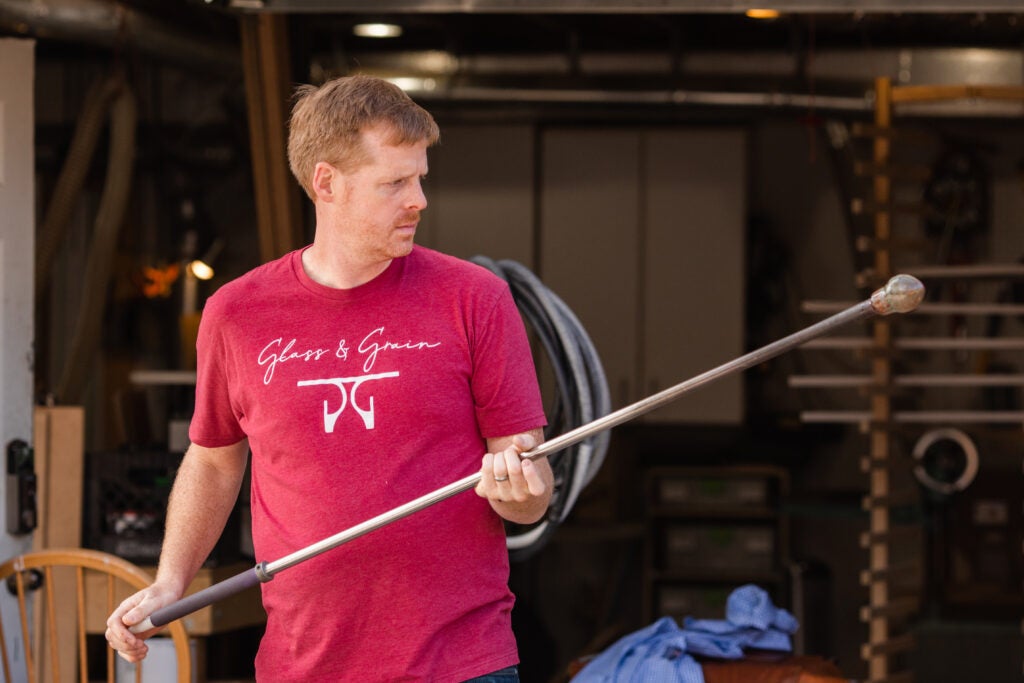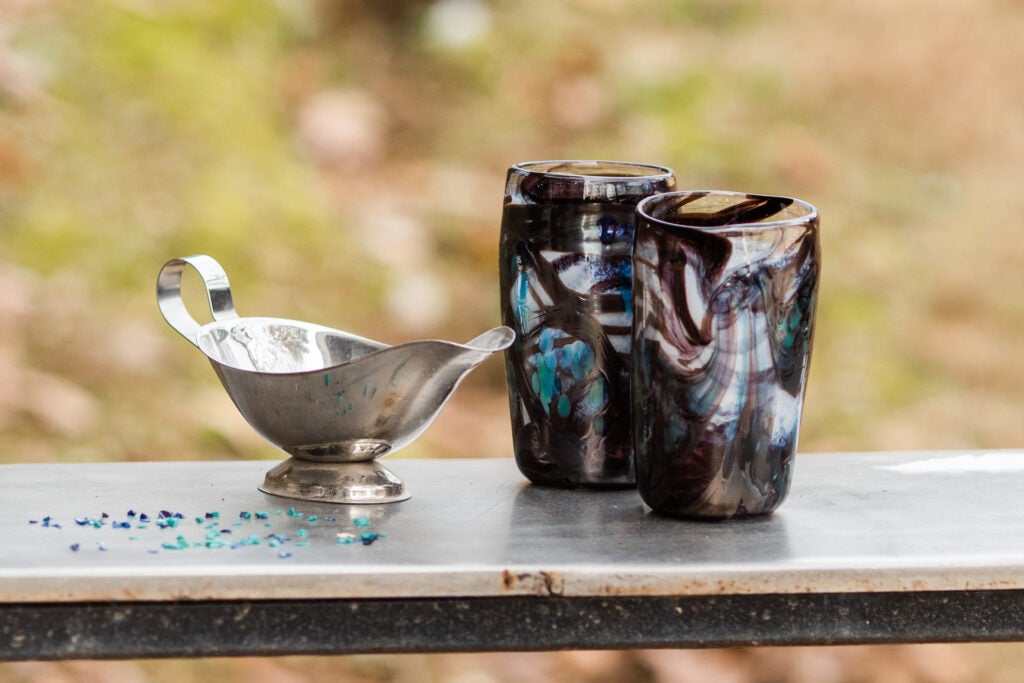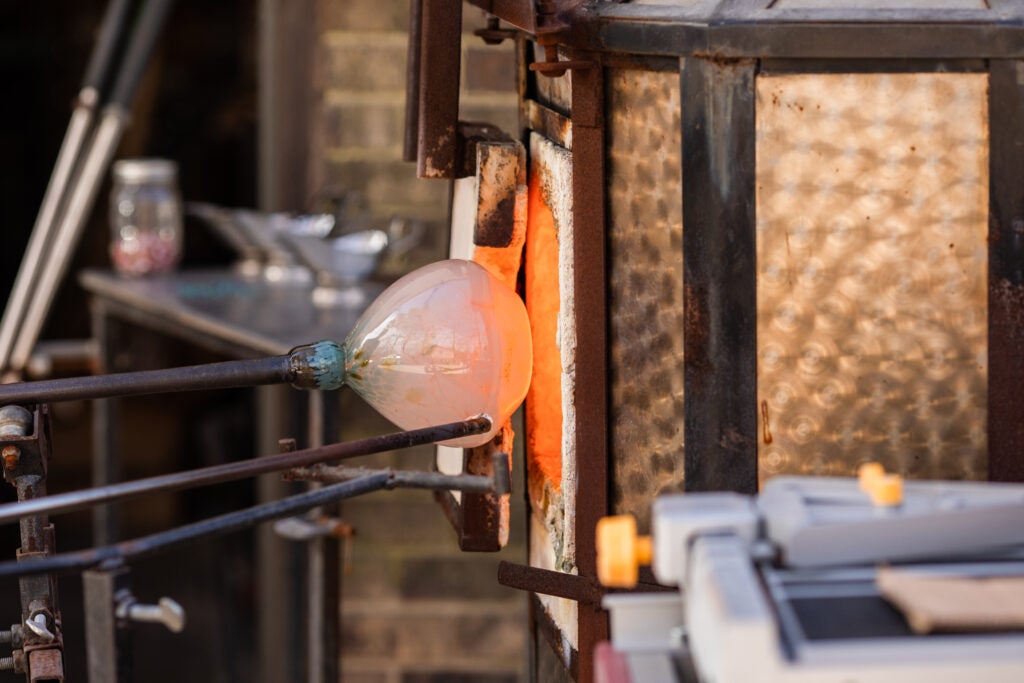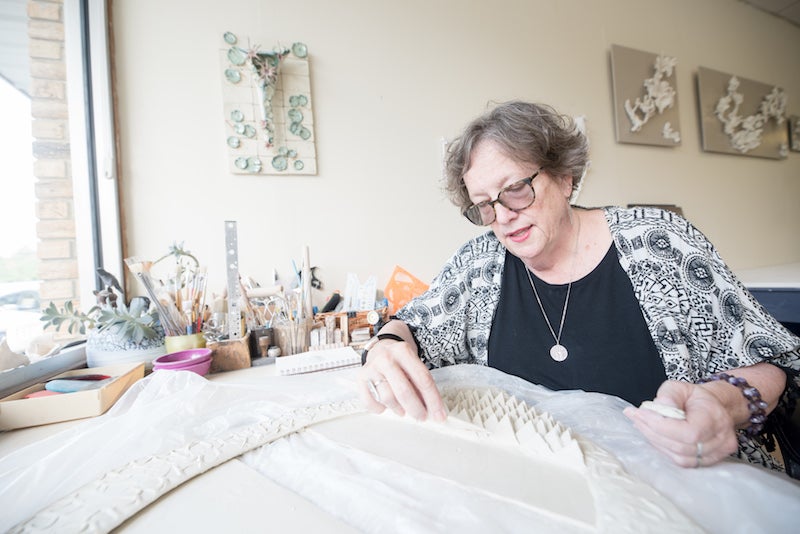By Elizabeth Sturgeon
Photos by Morgan Hunt
Glassblowing is a dance, choreographed with repetitive and rhythmic movements that shape each glass object. Honey-like molten glass balances on the end of the long blowpipe as its twisted or layered.
Micah Simpson always thinks of the glassblowing process this way, as a dance that relies on precision and strength, as well as curiosity in the shapes and colors that he can create. “You’ve got to move quickly and move with the glass,” he says. “If you don’t get your timing just right, or if you dance too slowly, the glass will shatter.”
The 2,000-degree heat point, the speed and intensity, and the color combinations that emerge have kept Micah involved in glassblowing for nearly 20 years, from his college classes in the studio to his current glass lowing and woodworking business, Glass and Grain.
Through Glass and Grain, Micah crafts hand-blown glass drinkware, bowls and vases as well as furniture and large built-in woodworking projects. He’s the only glassblowing artist in the Birmingham area that he knows of, and one of a small group throughout the state and the Southeast.
Glassblowing isn’t like other forms of glass art—it’s defined by the technique of forming the hot glass at the end of a long, five-foot pipe that the artist blows through to create a bubble and then further shapes from there. “You have to see it to really understand it,” Micah says. “It’s a big operation, not just a little torch. You can make some really large pieces.”
Micah’s creative and innovative spirit began with a childhood interest in drawing and painting and even building Legos, further sparked by living in New Orleans until he was 17 and seeing a deep-rooted appreciation for art. When he began a degree in accounting at Georgia Southwestern University (his creative side being met by a more mathematical half), he eventually stumbled upon the university’s glass studio.
This studio is a true gem as the only university glass studio in Georgia and one of less than 100 college programs around the country, and Micah began loading his schedule with extra classes in glassblowing. “It’s very captivating, and the process is intriguing,” he says. “There’s a danger element, and I like the challenge. Glass is probably the hardest medium to pick up, in all the mediums I’ve done.”
His glass work allows him to experiment with colors and styles within a very particular technique. “With glass, I like to throw things together and try them out,” Micah says. “Sometimes I stumble upon a combination of colors that you have to see in person. It’s fascinating what colors can do.” He loves creating these remarkable designs in what he thinks of everyday “vessels” like cups and bowls – objects that hold something else.
Micah decided to pursue his BFA after a few years of glassblowing, and he spent even more time in the glass studio and worked with painting, printmaking, metalworking and photography. After working with glass for hours each day, Micah then moved to Birmingham to attend Beeson Divinity School, thinking he left glass behind for a next step.
While in seminary, he found Bear Creek Studio, a glassblowing studio in downtown Birmingham where he would work 25 hours a week as their cold-work technician. Around 2009 when he graduated, Bear Creek closed, and Micah thought the glassblowing chapter had officially closed since he’d only be able to work whenever he was in Georgia.
With his seminary degree in hand, Micah began a role as the campus pastor at Southeastern Bible College, but with the need for pieces of furniture and renovations in his home, he started woodworking too. “When I didn’t have glass accessible, the creative spark was still very much alive,” he says. “It’s a fun process to make something the way you want it – the right fit and the right style.”
Micah first built a set of stairs in his home, and then built a bed frame when his wife, Heather, was pregnant. “We really needed it made quickly, so she could have it while she was pregnant,” he says, “and we’ve had it for ten years now. It’s stood up to our two boys wrestling on it, and it’s an heirloom piece.”
In 2017, with years of woodworking and glassblowing experience and while moving on from a nonprofit leadership job, Micah began to look at next steps and saw the blend of glass and grain—the mediums he’s made his own through years of practice and training. He created a workspace out of his own garage and driveway in Hoover to have room for tools and equipment.
Glass and Grain bring out different sides of Micah’s style. In his glass work, experimentation and spontaneity in the process generate striking color combinations with deep royal blues or warm golds. Woodworking brings out an extreme attention to detail in each piece. A professor once encouraged Micah to “consider the square you make,” which he does in the details of the custom wood pieces he puts into the world.
There’s a functionality in the mediums that Micah enjoys about both. With the glass, he makes cups and bowls and other objects you use on a daily basis. “Glass and art could be just something you look at,” he says, “but I want people to participate in the art.” The vessels he’s putting into the world are certainly beautiful objects, ones that you pay much more attention to than an average cup.
Micah’s blown glass turns vessels into what he calls considered objects. “You don’t usually consider the cup because you’re more interested in what’s in the cup. With the glass blown, handmade cups, people stop and consider the vessel,” Micah says. Though he’s worked on large-scale projects and sculptures—like the “Tree of Life” in Surgical Dermatology Group’s lobby with 100 pieces of glass-blown fruit—it’s the functional pieces like the everyday drinkware or the bed he made for his wife that mean the most to him.
The slowness it takes to stop and look deeper into an object—to make art a part of something as simple as drinking from a glass—is something Micah sees as going deeper, beyond the art, and representative of how we can interact in the world around other people.
“We’re so often more interested in what we can get out of someone than the person themselves,” he says. “But we hold memories and fears, and much more. It would be nice if we could always consider the vessel as much as we consider what’s in it.”
At the start of the new year, Micah finalized something big for Glass and Grain – a new studio space. Glass and Grain will soon be moving to a space in Avondale (4271 Morris Ave) that will allow for larger projects, group demonstrations, and hopefully classes. Plus, it’s now the only glass blowing studio in the city.
Follow Micah’s work on Instagram @glass_and_grain and learn more about it at glass-and-grain.com.
The Process
The key to glassblowing is keeping the material moving. “You start to have a feel for the heat,” Micah says. First, as the glass is heating up in the furnace, he takes a 5-foot-long blowpipe to gather the glass on the end, with molecules rapidly moving and expanding to be flexible and shapable. He uses a bench and different tools to manipulate the shape, then “dances” back to the reheating furnace to keep the texture moving until he gets the design he has in mind. The more glass you have, the more heat it captures and the more working time you have. You can see videos and photos of the full technique on Micah’s Instagram @glass_and_grain.










